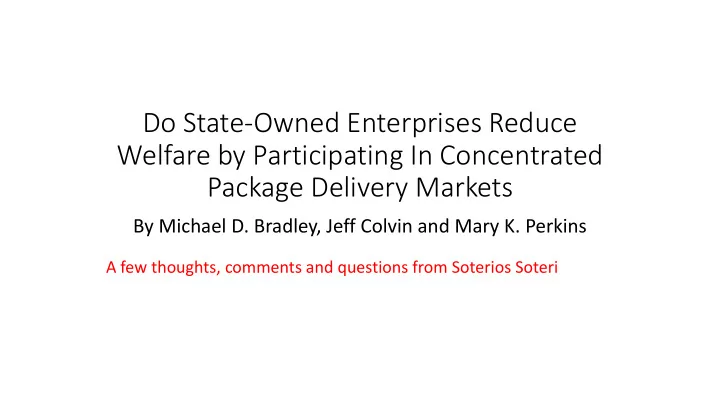

Do State-Owned Enterprises Reduce Welfare by Participating In Concentrated Package Delivery Markets By Michael D. Bradley, Jeff Colvin and Mary K. Perkins A few thoughts, comments and questions from Soterios Soteri
Theoretical model Model calibration Consumers maximise Firms maximise profit by setting prices Parameter values difference between utility and (Bertrand-Nash competition) cost Utility functions are quadratic State owned enterprise/ private parcel Private parcel Chosen to establish relative equilibrium - Yield linear demand equations company enterprise prices and volumes for mail and packages – Fixed costs of running postal network (USO) ‒ Only delivers parcels that mimic patterns in actual values Consumer costs – Impact of volume on marginal costs via ‒ Imperfect comp. and - Prices*no. of items*no. of senders And parameter values consistent with economies of scope between mail & parcels PPE has market power economic theory (e.g. own-price effects – No product-specific economies of scale greater than cross-price effects) – Mail monopoly subject to price cap regulation – Prices > average incremental cost Profit maximising equilibrium values under Bertrand-Nash competition , base case Prices MC Volume Revenue Profit & consumer welfare Mail price = cap SOE: Economies of Letters determined by price Letters determined by price SOE: $2,098 (23% of revenue, is scope significantly cap cap this consistent with price cap reg.?) SOE parcel c40% < private lower MC for L & P parcel enterprise (PPE) SOE share for L & P SOE share for L & P PPE: $3,656 (49% of revenue) PPE = calibrated value 85% & 15% 65% & 35% % mark-up over MC Consumer welfare: 21,927 utils SOE: L >80% P>165% Parcel share SOE & PPE Parcel share SOE & PPE PPE: P =95% 45% & 55% 30% & 70% Comments and questions - Is it reasonable to assume PPEs have significant market power in the parcel market? Or is this only reasonable in particular segments of the market? - In the UK parcels market is highly competitive with, on average, low parcel operator margins that is more consistent with monopolistic competition models. Is parcel competition in the USA to the UK?
Experiment 2. SOE precluded from package market Profit maximising equilibrium values, differences relative to base case Prices MC Volume Revenue P rofit & consumer utility Mail: no change Mail: +52% Mail: no change Mail: no change SOE profit: ? (Assume decline) SOE parcel: n.a. SOE parcel: n.a. SOE parcel: -100%. SOE parcel: -100%. PPE profit: +119% PPE parcel: +53% PPE parcel: +4% PPE parcel: +60% Consumer welfare: -36% PPE parcel: no change Total parcels: -41% Total parcels: +10% Notes and comments on results - Lower parcel competition leads to a sharp increase in parcel prices, lower volumes and a decline in consumer welfare - SOE letter MC increases due to absence of economies of scope Conclusion Delivery of packages by the SOE limits the market power and profitability of the PPE which leads to lower prices, higher package volumes and raises consumer welfare Questions – Directionally results seem sensible, but over long-term would new firms enter and erode much higher profit margins of PPE? – If new firms did enter, with, say, operational costs similar to the PPE and reduced profit to something similar to the base case, would this change the conclusion? I am not sure it necessarily would, as the existence of economies of scope between mail and parcels seems to be the main factor driving lower SOE prices, higher parcel demand and consumer surplus in the model. This question may be worth considering in future research. – What happens to SOE profit? Presumably it would decline? Helpful to include results in paper – Should the base case price cap remain unchanged in the experiment or change as a result of lower mail profit
Experiment 3: SOE is less efficient than the PPE Profit maximising equilibrium values, differences relative to post precluded from package market (experiment 2) Prices MC Volume Revenue Profit & consumer utility Mail: no change Mail: -10% Mail: no change Mail: no change SOE profit: ? Assume increases as parcel volumes generate revenue PPE parcel: -34% PPE parcel: no change PPE parcel: -1% PPE parcel: -34% that cover MC & letter MC declines (Note: SOE price (Note: SOE MC 43%> Total parcels: +22% Total parcels: -22% PPE profit: ? Assume decline 16% <PPE in expt 3) PPE in expt 3) (due to additional but small amount of SOE parcels) Consumer welfare: ? Increase Notes and comments on results In comparison to experiment 2, where the SOE is precluded from delivering parcels: ‒ The SOE now delivers some parcels but a relatively low number compared to base case (e.g. market share half of base case) ‒ Presence of SOE in package market significantly constrains pricing behaviour of PPE ‒ Economies of scope between L&P lowers letter MC and suggests SOE profit increases Conclusion Although the SOE is less efficient than the PPE, competition from the postal operator constrains market power of the PPE and their ability to raise prices. Overall this results in lower package prices and higher volumes than in experiment 2 and increases consumer welfare. Questions - Is it reasonable to assume PPE has significant market power in the parcel market? - If yes, then allowing the less efficient SOE to compete with the PPE, subject to parcel prices covering their incremental costs, would be a sensible economic outcome - What are the equilibrium SOE & PPE profit and consumer values for experiment 3 in the paper? Helpful to include in paper
Recommend
More recommend